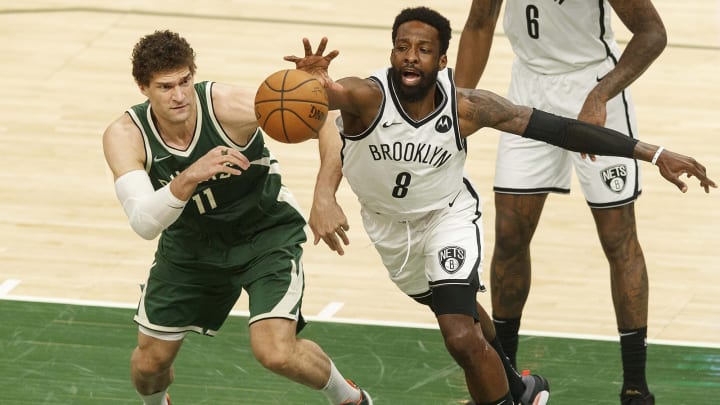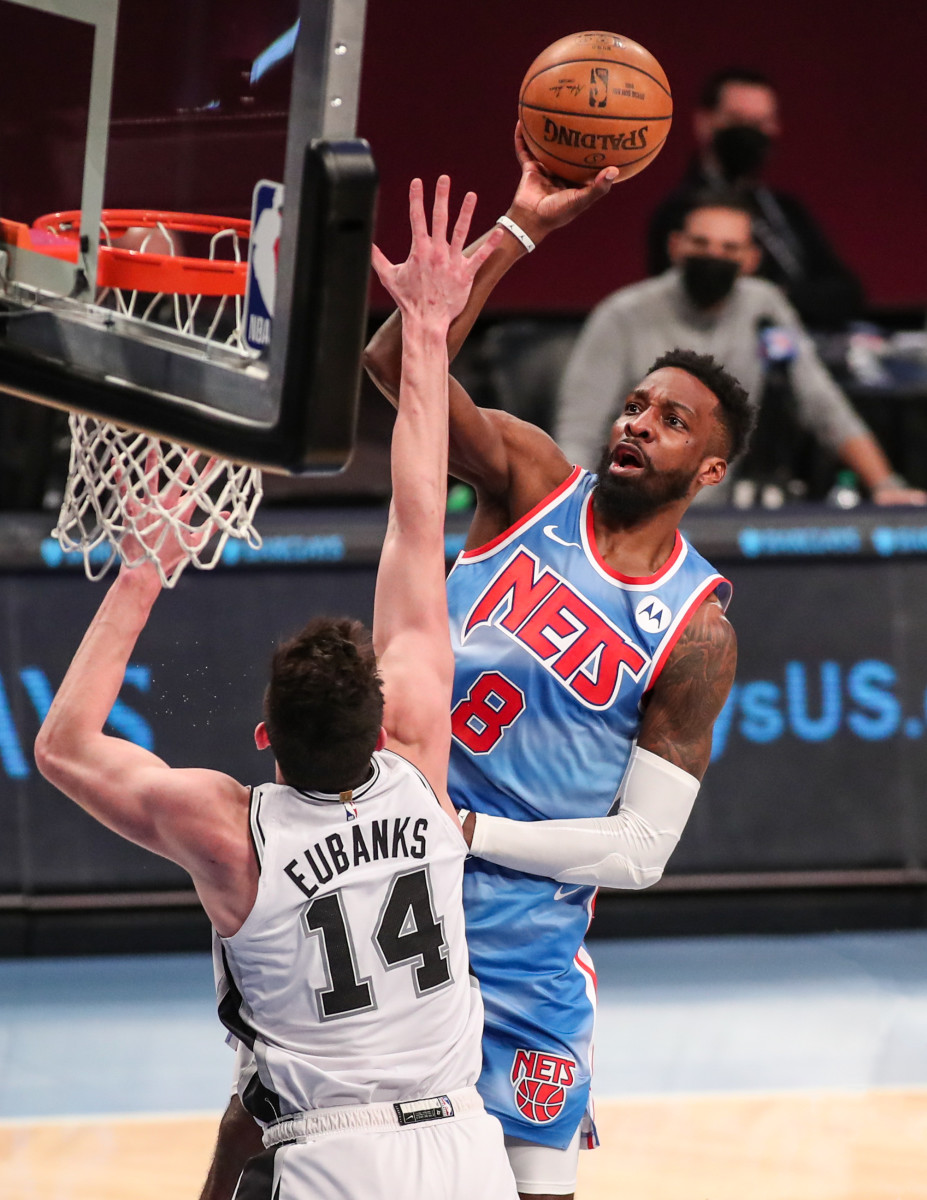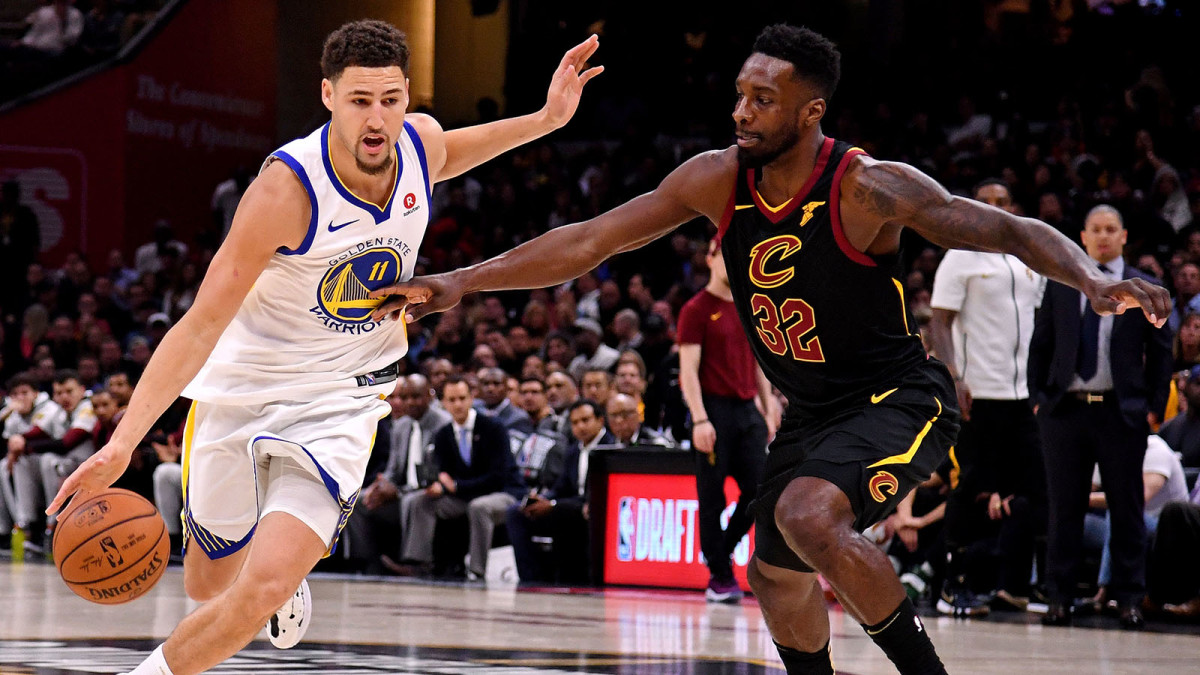How Jeff Green's Winding Road Landed Him in Brooklyn

Before his impressive playoff performance with the Nets, before 10 teams in 13 seasons, before the heart surgery that saved his life, Jeff Green had a decision to make.
Raised in Prince George’s County, MD—a basketball hotbed that served as the childhood home for Kevin Durant, Victor Oladipo and the late Len Bias—Green exited his high school career in the spring of 2004 with a flurry of programs looking to add the 6' 9" star. Green originally committed to Georgetown, then reopened his recruiting process when the Hoyas fired former head coach Craig Esherick. When Green ultimately walked on campus that fall, his arrival came as a surprise.
“I was very much shocked that Jeff was going to Georgetown,” former Georgetown and Pacers center Roy Hibbert says. “I played against him with a couple guys before we were freshman and I was like, ‘This guy should be going to the NBA right now out of high school.’ He was just an explosive talent with real ability.”
John Thompson III was surprised as well.
The son of Georgetown legend John Thompson took over as the program’s coach ahead of the 2004–05 season, and the addition of Green helped smooth what was a daunting rebuild for the former Big East power. The Green who came to Georgetown as a slender freshman mirrored the one suiting up for Brooklyn today.
Green played center for extended stretches as a freshman, but he was no back-to-the-basket bruiser. Much like the 2021 version, Green was able to put the ball on the floor and make plays for his teammates, serving as a primitive version of the point-forwards and point-centers populating the NBA today. Green would defend Syracuse forward Hakim Warrick one game and chase Villanova guard Randy Foye the next. He fit seamlessly into any lineup concocted by Thompson, moving from center back to the wing as Hibbert became a force to be reckoned with in the paint. As positional flexibility became more en vogue across basketball over the last decade, Green served as an early prototype.

Green’s versatility and playmaking prowess isn’t what stands out to Thompson more than a decade after Green last donned a Hoyas uniform. It’s Green’s basketball mind that takes precedent. He served as an extension of Thompson on the floor, dissecting defensive coverages and blowing up opponents’ offensive sets within the game’s first few possessions. Perhaps Green’s basketball brilliance is embedded in his DNA. Perhaps the influence of Prince George’s County is greater than we know. Regardless, Green’s basketball IQ prompted Thompson to tell Sports Illustrated in 2006 that Green is “the smartest player I’ve ever coached.” It’s a sentiment Thompson stands by 15 years later.
“I still feel that way,” Thompson says. “When you tell Jeff something, he understands what you’re telling him; he understands why it’s important. He understands when to do it, and he understands when to ignore you and do something else.”
“You talk about the players that know their position, but then all the other positions on the floor? That’s Jeff. The game comes slow to him. He can see situations developing.”
Green evolved into a bit of a journeyman during his NBA career. Only eight players in league history have ever taken the floor for more franchises, and he is one of two players in league history to tally more than 12,000 points while playing for at least 10 teams. Such a winding road wasn’t expected for Green as he exited college. Green was a two-time All-Big East honoree and the 2006–07 Big East Conference Men’s Basketball Player of the Year. He helped lead Georgetown to the Final Four as a junior, and he battled Buckeyes behemoth Greg Oden admirably in the ’07 national semifinal. Green was selected with the No. 5 pick in the ’07 NBA draft, joining Durant in Seattle as a presumed franchise anchor. And early indications pointed to a successful pairing for the sons of Prince George’s County.
As Durant quickly ascended toward All-Star status, Green settled into a role as a productive young player under the tutelage of P.J Carlesimo and then Scott Brooks. Green jumped to 16.5 points per game in his second season with the Thunder after their move from Seattle, and he started all 82 games the following season. The 2009–10 Thunder won 50 games following a dismal 23–59 campaign the year prior, and Green finished the season sandwiched between Russell Westbrook and James Harden on the team’s scoring leaderboard. Oklahoma City’s playoff run ended in a first-round loss to the Lakers (the eventual champions), but spirits were high across the organization as Durant, Green and the Thunder’s young core got their first taste of playoff basketball.
“Our first few years together in the NBA, [Durant] made it easy on me,” Green says. “It was amazing. Two guys coming from the same area in Prince George’s County. With his work ethic and my work ethic, he pushed me to be better. It led to growth for both of us.”
“Obviously we’ve taken different routes in the NBA, but we’re both still playing today.”
There’s an alternate reality in which Durant, Westbrook, Harden and Green grow as a young core, potentially emerging as the team of the decade with two superstars, a frontcourt presence and a supercharged version of Manu Ginóbili. A combination of injuries, Sam Presti trades and free-agency decisions provided a far different history. Green’s time in Oklahoma City was short-lived and Harden was dealt far too soon. Durant left the Thunder in July 2016. Three years later, Westbrook followed. What was once a potential dynasty is now the NBA’s greatest what-if of the century.
Green’s exit from Oklahoma City came five years before Durant’s, and it wasn’t by choice.
Green was traded to the Celtics in February 2011, swapped for Kendrick Perkins and Nate Robinson as the Thunder eyed a potential run to the Finals. The move didn’t exactly pay dividends for Oklahoma City, whose late-game offense consistently stalled in the postseason in subsequent years. Durant didn’t have the requisite spacing to succeed as Westbrook, Perkins, Nick Collison and Thabo Sefolosha served as non-shooters. Robinson played just four games for the Thunder. Perhaps Green would have provided a much-needed dose of playmaking and shooting had he been on Oklahoma City’s roster for the 2011–16 postseasons.
Leaving the Thunder didn’t send Green into NBA exile in any sense. His scoring and minutes dipped in his first season with Boston, but he still served a notable role on a 56-win team with true Finals aspirations. The Celtics were bounced from the playoffs by the first iteration of the LeBron James–era Heat in the spring of 2011, with Green battling Jermaine O’Neal, Glen Davis and Shaquille O’Neal for frontcourt minutes alongside Kevin Garnett. With the three aforementioned big men past their prime, the ’11–12 season set up to be a major year for Green’s development. He could become the missing piece to revive an aging Celtics core, one that still had Rajon Rondo, Paul Pierce and Ray Allen performing near an All-Star level. Green’s body had other ideas.
It was a quiet summer for Green by most accounts. He trained for his first full season with the Celtics, joined fellow Georgetown alumni for workouts and approached the 2011–12 season ready for a significant role on a new potential title team. That changed during the annual league-mandated physical before the season.
Doctors detected an aortic aneurysm in December 2011, shortly after Green agreed to a one-year, $9 million contract with the Celtics. Green played in 315 of 328 potential regular-season games in his first four NBA seasons from ’07–11. He was a paragon of health, just 25 years old with potentially $100 million in career earnings ahead of him. The news came as a shock, though as usual, Green’s preparation mitigated his fear. And upon exiting surgery, Green says he had a newfound appreciation for the game he loved.
“It all came as a surprise,” Green says. “I didn’t have any symptoms. No shortness of breath. No heart palpitations. ... It crossed my mind that it was the last time I’d play.”
“It’s been something I’ve taken with me to this day. You only get so much time to play this game. You better cherish each moment.”
The path to playing again was simple as Green remembers it. “You just had to walk,” he says. “That was it, to be honest with you; that’s all I did.” But the simplicity shouldn’t be conflated with a low degree of difficulty. Green recalls his first days of rehab after his surgery, where one of the NBA’s best athletes struggled to walk from the baseline to the three-point arc.
“First three days I probably walked maybe 10 steps before I had to turn around,” Green says. “You had to get the lungs better conditioned. For three or four days walking was it. Get up, stand up, see how far you can walk. Get too tired, sit down and that’s it.”
Green’s lungs responded well to the arduous physical therapy, and he was back on the court in time for the 2012 opener after a yearlong absence. Yet his return didn’t exactly coincide with the rise of Boston as a title contender. The ’12–13 season was the last year with Pierce and Garnett on the roster, a 41–40 campaign that ended in a first-round loss to the Knicks. As Boston transitioned to a new era, Green was dealt to Memphis in January 2015.
The deal kickstarted a nomadic period for the former Thunder building block. Leaving Boston led Green to play for eight franchises over the next six years, including his current stint with Brooklyn. Middling seasons with the Grizzlies, Clippers and Magic signaled Green’s standing in the league was waning as he crossed the decade mark. But playing alongside another all-time great revived his career.
There’s a certain threshold of talent one must have to play more than a decade in the NBA, and at his best as a young player, Green showed flashes of All-Star potential. But Green’s true value is best displayed when paired with the top talents in the game. He quickly served as a dynamic pick-and-roll threat with Durant and Westbrook shortly after leaving Georgetown, sometimes even inverting the two-man game to control the possession as a ballhandler. Green feasted on pick-and-pop attempts alongside Harden in Houston last season, when the duo posted a dominant 122.8 offensive rating in 189 minutes.
Green’s basketball instincts are on full display alongside league luminaries. He knows exactly when to slip a pick and dive to the rim. He’ll initiate hand-offs and set back screens, and when he’s free to make a play in space, he’s more than willing to drive downhill and attack the rim. Incessant traps of Harden slowed the Rockets’ offense to a crawl with center Clint Capela on the floor last season. Inserting Green as a small-ball five returned Houston’s attack toward the top of the league.

Green’s defining NBA moment to date came alongside LeBron in May 2018. Green turned in an uneven regular season in his first campaign with the Cavaliers in ’17–18, a year that wasn’t exactly smooth sailing for Cleveland writ large. Isaiah Thomas played just 15 games after being acquired in the Kyrie Irving trade. A 6–12 stretch from Dec. 27 through Feb. 6 resulted in a roster overhaul, with Jordan Clarkson, Larry Nance, Rodney Hood and George Hill arriving just two months before the playoffs. James’s brilliance carried the Cavaliers through the first two rounds, though in the Eastern Conference finals, the King needed at least a modicum of help.
A collision with Jayson Tatum ended Kevin Love’s series for Cleveland early in Game 6 of the conference finals, dealing a major blow to a Cavs team desperately lacking firepower. But with Love sidelined, Green stepped up. He tallied 14 points off the bench in Game 6, posting a plus-10 in 31 minutes. His role in Game 7 was even more pronounced. Green finished second on the Cavaliers in scoring, adding 19 points and eight rebounds in an 87–79 Cleveland win. His three with 5:44 remaining gave the Cavaliers a lead they would never relinquish, sending James to his eighth consecutive Finals. As Boston swarmed the all-time great, Green continued to find cracks in its defense. More than a decade after he impressed Thompson at Georgetown, Green’s basketball intellect helped fuel another crucial victory.
“Being in pressure situations, you understand the moment,” Green says. “Winning the Big East regular-season title, winning the Big East championship, getting to the Final Four, those are major-pressure situations in college. One loss and you’re out.”
“That’ll make you battle-tested, and it transferred to the NBA.”
The Cavaliers were subsequently squashed by the Warriors in the Finals, and the Rockets were summarily bounced from the bubble after running into the Lakers in 2020. Green’s NBA legacy is already secured, with more than 12,000 points and 2,000 playoff minutes on his career ledger. Though without a championship, there may always be a missing piece to Green’s extensive career.

Perhaps Green will be able to finally hoist the Larry O’Brien Trophy next month. He joined Durant and Irving in Brooklyn with his eyes firmly set on the Finals, a goal that became increasingly attainable following Harden’s arrival early in the season. It’s been an uneven ride as of late for Brooklyn, with injuries to both Harden and Irving placing the Nets’ standing in the title chase in a precarious position. But tied 2–2 vs. Milwaukee and with Kyrie Irving sidelined on Tuesday night, Green stepped up again.
It looked like Oklahoma City circa 2008 in Brooklyn as the Nets erased a 16-point Bucks lead to seize a 3–2 lead in the Eastern Conference semifinals. Durant turned in a historic performance, playing all 48 minutes as he scored 49 points along with 17 rebounds and 10 assists. As Harden limped through the contest in a 1–10 shooting effort, Green emerged as Durant’s primary scoring partner. Just as he did in ’18 alongside James, Green finished second on the Nets in scoring, adding 27 points and seven threes. If Brooklyn clinches the title, Green could be remembered as a crucial role player on a championship team, similar to Mike Miller, Shaun Livingston and Robert Horry over the last 20 years.
We won’t etch the Nets’ name on the championship trophy just yet. The Bucks are still alive in the second round, and a healthy Joel Embiid could provide a problem in the Eastern Conference finals. Any of the three remaining Western Conference teams may provide a formidable challenge, and frankly, Brooklyn’s largest problem might be its own health. Green could very well enter his 14th season in 2021–22 without a championship on his résumé, with another opportunity missed as he looks to elongate his career. Thompson isn’t concerned.
Green is the NBA’s ageless wonder, one whose mental dexterity and physical gifts have allowed him to remain a quality contributor as he approaches his 35th birthday. Another NBA season is a small task compared to open heart surgery. Regardless of the Nets’ playoff finish, you can expect to see Green in the postseason once again in 2022, looking to elevate the league’s top stars in pursuit of a championship. Green’s winding journey is one of the most unique in NBA history. And he’s not done just yet.
“Uncle Jeff still has a lot of ball left in him,” Thompson says. “He has a lot of winning to do before he hangs it up.”
More NBA Coverage:
• How the Suns Mastered the Pick-And-Roll
• Rudy Gobert's Playoff Defense Is Better Than Ever
• Kevin Durant's Historic Performance Lifts Nets Over Bucks In Game 5
